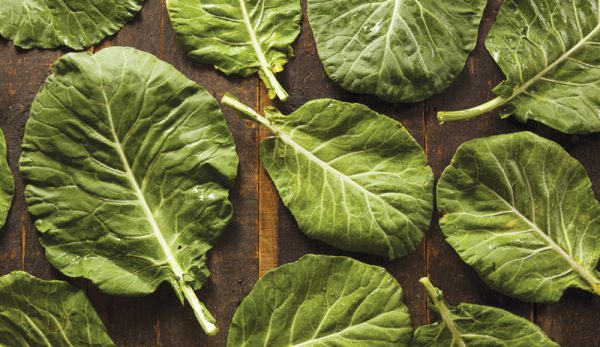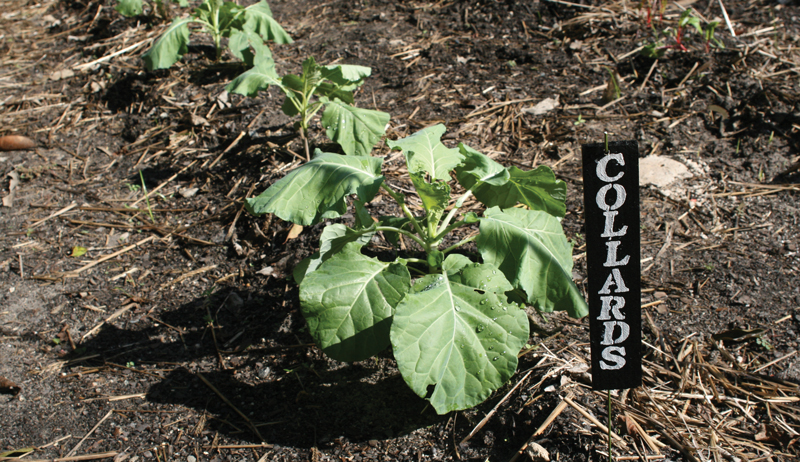
Collard greens have a long history dating back at least a few thousand years, when people of the northern Mediterranean started cultivating wild cabbage. From that one plant, which most likely originated in Asia before its recorded history, farmers created plants as diverse as the human population.
Broccoli, cauliflower, Brussels sprouts, kale, savoy, kohlrabi and collard greens all belong to the same species, making them siblings on the taxonomic family tree.
Many cuisines around the world boil greens. This practice is ubiquitous in African countries. One of my favorite dishes is gomen wat, a vegetarian Ethiopian stew (wat) that combines spices and boiled greens (gomen). The dish is transported from plate to mouth with pieces of injera—a delicious, spongy textured, fermented flatbread.
African slaves in the United States tried to replicate dishes reminiscent of their native countries by combining unwanted collard greens, vegetables and meats. The leftover juices, known as pot likker, were consumed by soaking it up with cornbread.
Read more: Collard greens offer growers year-round nutrition.
Headless Powerhouse
Collards are more heat- and cold-tolerant than many other vegetables, allowing for an extended growing season. They contain a lot of protein and minerals but few calories. One cup of cooked collard greens provides 212 percent daily value of vitamin A, 39 percent vitamin C and 18 percent calcium.
In that same single serving, collards provide nine times the daily value of vitamin K.
Although a member of the cabbage family, collards don’t form a central head. They are part of the acephala group. (Acephala is Latin for “without a head.”) The word “collard” comes from the Anglo-Saxon word colewort, which means cabbage.
These headless cabbages are then, of course, grown for their leaves, which taste sweeter after a light frost. As the temperature drops, collards, just like their siblings, break down their stored starch into glucose and other sugars, resulting in a sweeter taste.
Growing your own collards lets you harvest the leaves at the optimal time.
Growing Greens
To prepare the soil, dig to at least 10 inches, as collards’ roots can extend 2 feet or more. The loosening of the soil allows the small feeder roots to expand their search for nutrients and water. Add organic matter if the soil is mostly sand or clay.
Spread a layer of 4-inch compost over the planting area.
Plants can be started from transplants or directly sown in the garden. Transplants always work better for me. Collard seeds germinate when the soil temperature reaches 45 degrees Fahrenheit. On average, the seeds come up after 6 to 12 days.
The colder the soil is, the more time the seeds take to sprout.
For a fall crop, plant seeds 80 days before the frost date. (For the spring crop, I start the seeds in my greenhouse about a month before I want to transplant them into the ground.) Space seedlings 18 to 24 inches apart.
Using hay-bale twine, I tie the small plants to a piece of wood or bamboo to ensure they grow straight.
Collards require a lot of nitrogen to develop dark green leaves. If plants become a pale green, add a little more fertilizer such as a 10-10-10. One cup of fertilizer for a 10-foot row should be enough.
Water the plants thoroughly once a week if it doesn’t rain. Because of the canopy of the collards, weeds are usually not a problem. If weeds persist, pull them or carefully remove them using a hoe. Unwanted plants steal collards’ nutrients and water.
Common pests include aphids, harlequin bugs and cabbage loopers.
- Aphids suck the plant juices and are found on the underside of leaves.
- Harlequin bugs also suck the plant juices, causing the plant to wilt and the leaves to turn brown.
- Cabbage loopers feed on the foliage and resemble a light green, pale yellow or white inchworm.
For organic pest options, manually remove the bugs or use a Bt-based insecticide and sulfur, which can help with many diseases. Neem oil also helps if plants show spots on the leaves, indicating a fungus.
Read more: Row cover offers protection from pests and extends your growing season.
Varieties for Your Garden
- Georgia Southern (Creole) is a pre-1880 heirloom that produces a huge yield. Tasty and flavorful. 70 days
- Morris Heading yields a loose head that is dark green and slow to bolt. 45 days
- Top Bunch is a Georgia-type hybrid with semi-savoyed leaves that grow 18 to 26 inches. 50 days
- Vates originated in the 1950s, when it was admired as a “new, dwarf strain.” Like all collards, it’s longstanding and heat resistant. 75 days
- Yellow Cabbage collards were originally cultivated in North Carolina in 1887, and this variety is tenderer and less bitter. It’s reminiscent of spinach but can handle heat and humidity. 45 days
Harvesting Help
While some people harvest the entire collard green plant, it’s more common to remove a few of the lower leaves from each plant. This lets the plant keep growing and produce more leaves.
If the central stem of the leaf is greater than half an inch, it can be tough and unpleasant to eat. Cooking such leaves for half a day softens them up. For fast recipes, remove the stem with a knife by folding the leaf in half. You can save the stem for vegetable stock.
You can also add the stalks to a bag of frozen vegetables such as carrot knobs, celery leaves, herb stems and onion skins, all of which make a delicious soup base.
Once you have a pile of destemmed collards, roll them and give them a rough chop. Place the chopped leaves into a deep water-bath for half a minute to remove the debris.
Now you’re ready to start cooking a mess o’ greens.
Recipes

Ethiopian-Style Collards
Ingredients
- 3 pounds collard greens, washed and torn
- 6 cups water
- 3 tablespoons olive oil
- 1 onion, diced
- 8 cloves garlic, chopped
- 1 bell pepper, diced
- 3 tablespoons lemon juice
- 1 tablespoon salt
- 1 tablespoon ground turmeric
- 6 tablespoons fresh ginger root, minced
- 1 tablespoon paprika
- 1 tablespoon ground allspice
Preparation
Bring to a boil chopped collard greens in 6 cups of water and then reduce heat to low.
Cover for 20 minutes until collards are tender.
Heat olive oil and onions over medium heat until brown.
Stir in garlic, cooked collards and their liquid.
Simmer uncovered for about 10 to 15 minutes until liquid is almost evaporated.
Add green pepper slices, lemon juice and remaining spices. Cook for an additional 5 minutes.
Vegetarian-Style Collards
Ingredients
- 1 medium onion, diced
- 1 tablespoon olive oil
- 1 tablespoon butter
- 1 teaspoon red pepper flakes
- 1 clove garlic, finely chopped
- 1 pound collard greens, washed and torn
- 3 cups vegetable stock
- 2 tomatoes, chopped
Preparation
In large pot, sauté onion in oil and butter over medium heat until softened. Add red pepper flakes and garlic, cooking for an additional minute
Add collard greens, cook another minute. Add vegetable stock and simmer for 40 minutes until greens are tender.
Serve with chopped tomatoes.
Southern-Style Collards
Ingredients
- 3 pounds collard greens, washed and torn
- 2 to 3 ham hocks
- 5 cups water
- 1 bell pepper, diced
- 2 teaspoons salt
- 1 teaspoon black pepper
- 1 onion, diced
- 2 teaspoons apple cider vinegar
- 1 tablespoon garlic, minced
Preparation
Cook ham hocks in water in slow cooker on high for 3 hours or until tender.
Sauté collard greens, onions, peppers, garlic, vinegar and seasonings. Add wilted vegetables to slow cooker. (They need to be wilted first to fit into the slow cooker).
Cover and cook on low for 4 to 6 hours.
Serve with cornbread.
This article originally appeared in the May/June 2019 issue of Hobby Farms magazine.




